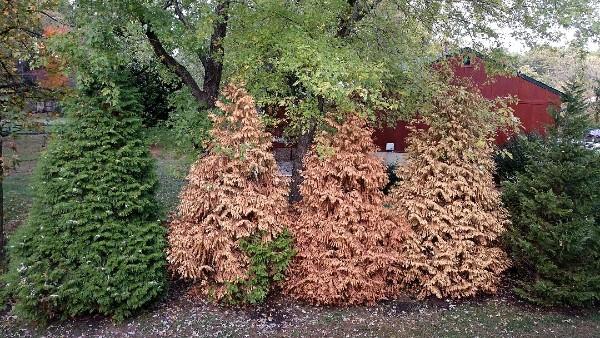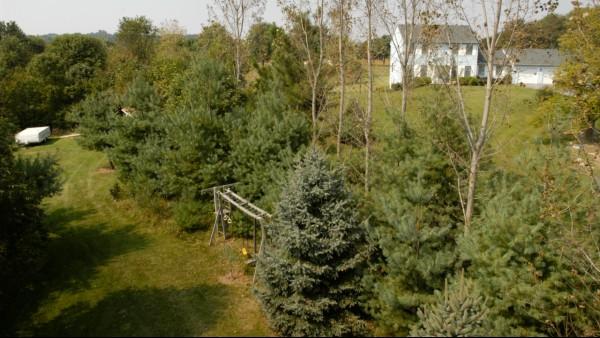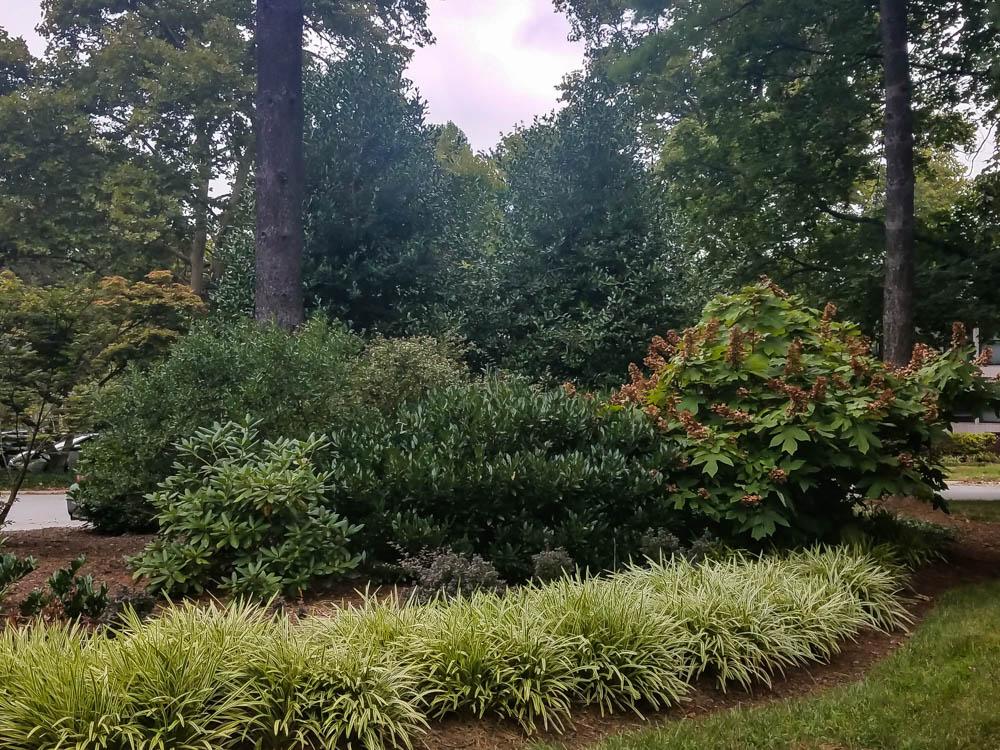Key points about planting privacy screens
- Choose a variety of different plants for your privacy screen rather than many plants of a single kind.
- Screens with a variety of plants are more resilient to diseases, pests, and climate change.
- Prioritize native plants and avoid invasive ones such as bamboo and Japanese barberry. A variety of options are provided in the list below.
Whether your goal is to plant a screen to create privacy, reduce noise, or block an unsightly view, these practices are recommended to help you achieve your project successfully and sustainably.
Choose a variety of different plants for your privacy screen
- Create a natural screen by using a variety of different plants rather than a row of all the same type. A mixed screen will be more resilient to challenges such as droughts, flooding, pests, and diseases.
Climate change is causing more extreme weather fluctuations in Maryland. In an extremely rainy year, for example, plants that are intolerant of wet soil (e.g., yews) may not survive. If you have a screen consisting of just one kind of plant and a problem occurs, you risk losing the investment you made in an entire row of plants. A mixed planting that consists of a variety of different plant species provides some assurance that if one type of plant develops problems, you will not lose the whole row to the same issue.
- A screen with plant diversity has added benefits. Structural diversity refers to layers of plants of different heights and forms (trees, shrubs, ornamental grasses, groundcovers). Landscapes with more structural diversity a) have greater visual interest and b) support more wildlife such as pollinators and beneficial insects that provide the services of pollination and pest control. Studies have shown that landscapes with more plant species and structural diversity tend to have fewer pest outbreaks.
- A mixed screen can be designed to have a neat and tidy appearance. Layer larger plants as your backdrop with medium-height plants in front and between them and put ornamental grasses or groundcovers around the perimeter.

Photo: University of Maryland Extension

Choose native plants for your screen
The use of native plants has advantages:
- Native plants are adapted to local soils and climate conditions and generally require less fertilizing and watering once they are established. (Read What is a Native Plant?)
- Native plants interact favorably with natural areas beyond your property. Plants in your screen may have berries, seeds, or pollen that will disperse into wild areas by wind, water, and/or wildlife. If you choose native plants, their dispersal and cross-pollination with plants in natural areas will support local ecosystems and wildlife rather than harm them.
- Native plants support wildlife. Songbirds, butterflies, and other types of wildlife rely on native plants for food and habitat. Populations of birds, insects, and other beneficial wildlife are in decline due to habitat loss. Your plant choices matter and can support animals that provide pollination, pest control, and natural beauty.
- Our plant list includes species that are native and adapted to the Maryland Coastal Plain (C), Piedmont (P), and Mountain (M) regions. Refer to the Chesapeake Bay Native Plant Center page to find your region.
- Refer to the Maryland Native Plant Society for sources of native plants.
Avoid invasive plants
Make sure your plant choices are not invasive in Maryland. Some exotic, non-native plants used for screens in the past (bamboo, European privet, Chinese silvergrass, Chinese wisteria, Japanese barberry, and burning bush) are now invasive in natural areas.
Invasive plants are problematic because they grow rapidly and displace native plants, change soil chemistry, degrade wildlife habitat, and alter fire frequency. It is costly to the state and residents to mitigate the effects of invasive species.
Refer to the Maryland Department of Agriculture’s list of invasive plants and the (PDF) Plant Invaders of Mid-Atlantic Natural Areas Field Guide.
Make informed decisions
Our basic plant list provides a few options to consider for privacy screening. Take time to research these plants in greater detail to become familiar with the growing conditions they require and their suitability for your location. Consider:
- Will your site accommodate the mature height and width of the plants?
- Do the plants tolerate existing growing conditions such as dry or wet soil?
- What is the natural climate range of the plants?
- Do you have access to a water source for irrigation?
- Are utilities located above or below the planting area?
Deer-resistance ratings are provided for general guidance. They are not a guarantee that deer will avoid your plants. Any of the plants on this list may be browsed if deer populations are high and deer are hungry. Deer tend to taste a variety of plants and prefer tender new growth. Deer damage may occur on young plants more so than on older plants. Protect new plants with tree tubes or fencing if deer pressure is high.
Some good resources to use for research on plant characteristics include:
Plant correctly for success
It is essential to plant correctly so that your natural screen becomes established successfully in its first one-to-two years.
- Test your soil prior to planting and contact Miss Utility before you dig.
- Read our guidelines on how to plant container trees and shrubs. Be mindful of planting depth and root placement as well as watering. For example, roots circling around the outside of the root ball should be pruned and spread out in the planting hole.
- Avoid excess mulch. A mulch layer should be no more than 2-3” deep and avoid placing mulch directly against tree trunks.
- Provide adequate spacing for your plants. Plants that are crowded will compete for water, nutrients, and light, resulting in a decline over time.
By investing time in proper planting and plant care, you will be on track to enjoy a beautiful and sustainable natural privacy screen for years to come.
Evergreen trees for privacy
| Common name | Botanical name | Height | Width | Sun/shade | Native to Maryland? | Deer resistance? |
|---|---|---|---|---|---|---|
| White Fir | Abies concolor | 30-50' | 15-30' | Full Sun | No | No |
| Atlantic White Cedar, False Cypress | Chamaecyparis thyoides | 40-50'+ | 10-20' | Full Sun | Yes (Coastal Plain) | No |
| Deodar (Himalayan) Cedar | Cedrus deodara ‘Karl Fuchs' | 12-15' | 4-6' | Full Sun to Part Shade | No | No |
| Japanese Cryptomeria | Cryptomeria japonica | 50-60' | 20-30' | Full Sun | No | Yes |
| Arizona Cypress | Cupressus arizonica | 40-50' | 25-30' | Full to Part Shade | No | Yes |
| Leyland Cypress | xCupressocyparis leylandii | 60-70' | 15-25' | Full Sun | No | No |
| Foster’s Holly | Ilex x attenuata 'Fosteri' | 20-30' | 10-20' | Full Sun to Part Shade | No | No data |
| American Holly | Ilex opaca | 15-30′ | 10-20′ | Full Sun to Shade | Yes | Yes |
| Nellie Stevens Holly | Ilex x ‘Nellie R. Stevens’ | 15-25' | 8-12' | Full Sun to Part Shade | No | No |
| Hollywood Juniper | Juniperus chinensis 'Torulosa' (also 'Kaizuka') | 20-30' | 6-10' | Full Sun to Part Shade | No | Yes |
| Eastern Redcedar | Juniperus virginiana | 40-50' | 8-20' | Full Sun to Part Shade | Yes | Yes |
| Southern Magnolia | Magnolia grandiflora 'Brackens Brown Beauty' | 20-30' | 15-25' | Full Sun | No | Yes |
| Sweetbay Magnolia (semi-evergreen) |
Magnolia virginiana | 12-30' | 12-30' | Full Sun to Part Shade | Yes (Piedmont and Coastal Plain) | Yes |
| Norway Spruce | Picea abies | 40-60' | 25-30' | Full Sun | No | Yes |
| Eastern White Pine | Pinus strobus | 50′-80’+ | 20′-40′ | Full Sun | Yes (Mountains and Piedmont) | No |
| Arborvitae (American) | Thuja occidentalis | 40-60' | 10-15' | Full Sun | Yes (Mountain Region) | No |
| Arborvitae (Green Giant) | Thuja plicata 'Green Giant' | 40-50' | 12'-18' | Full Sun to Part Shade | No | Yes |
Evergreen shrubs for privacy
| Common name | Botanical name | Height | Width | Sun/shade | Native to Maryland? | Deer resistant? |
|---|---|---|---|---|---|---|
| Japanese Plum Yew | Cephalotaxus harringtonia 'Fastigiata' | 10-12' | 6-8' | Full Sun to Shade | No | Yes |
| Japanese False Cypress | Chamaecyparis pisifera cultivars | 10-40' | 10-20' | Full Sun | No | Yes |
| Dragon Lady Holly | Ilex x aquipernyi Dragon Lady® | 10-20' | 4-6' | Full Sun to Part Shade | No | Yes |
| Inkberry Holly | Ilex glabra | 5-8' | 5-8' | Full Sun to Part Shade | Yes (Coastal Plain) | Yes |
| Chinese Juniper | Juniperus chinensis 'Hetzii' | 15' | 15' | Full Sun to Part Shade | No | Yes |
| Rocky Mountain Juniper | Juniperus scopulorum 'Blue Arrow', 'Skyrocket' | 12-20' | 2-3' | Full Sun | No | No |
| Wax Myrtle, | Morella cerifera | 6-15' | 10-15' | Full Sun to Part Shade | Yes (Coastal Plain) | Yes |
| Japanese Pieris | Pieris japonica | 9-12' | 6-8' | Full Sun to Part Shade | No | Yes |
| Skip Laurel | Prunus laurocerasus 'Schipkaensis' | 10' | 7' | Full Sun to Shade | No | Yes |
| Hick's Yew | Taxus x media 'Hicksii' | 10-12' | 3-4' | Full to Part Shade | No | No |
| Arborvitae (Emerald) | Thuja occidentalis 'Emerald' or 'Smaragd' | 10-15' | 3-4' | Full Sun | No | No |
| Prague Viburnum | Viburnum 'Pragense' | 10-12' | 10-12' | Full Sun to Part Shade | No | Yes |
| Leatherleaf Viburnum | Viburnum rhytidophyllum | 10-15' | 10-15' | Full Sun to Part Shade | No | Yes |
| American Olive | Cartrema americana | 10-20' | 10-20' | Full Sun to Full Shade | No (native to Southeast USA) |
Yes |
Deciduous shrubs for privacy
| Common name | Botanical name | Height | Width | Sun/shade | Native to Maryland? | Deer resistant? |
|---|---|---|---|---|---|---|
| Glossy Abelia | Abelia × grandiflora | 8' | 8' | Full Sun | No | Yes |
| Red Chokeberry | Aronia arbutifolia | 2-10' | 3-5' | Full Sun to Part Shade | Yes | No data |
| American Beautyberry |
Callicarpa americana | 3-8' | 3-6' | Full Sun to Part Shade | Maryland nativity uncertain | No |
| Carolina Allspice | Calycanthus floridus | 6-10' | 6'-12' | Full Sun to Part Shade | Yes (Mountain Region) | Yes |
| Buttonbush | Cephalanthus occidentalis | 5-12' | 8' | Full Sun to Part Shade | Yes | No data |
| Sweet Pepperbush | Clethra alnifolia | 3-10' | 4-6' | Full Sun to Part Shade | Yes (Coastal Plain) | Yes |
| Large Fothergilla | Fothergilla major | 6-10' | 5-9' | Full Sun to Part Shade | No | No |
| Winterberry Holly | Ilex verticillata | 6-12' | 10' | Full Sun to Part Shade | Yes | Yes |
| Common Elderberry | Sambucus canadensis | 6-12' | 6-12' | Full Sun to Shade | Yes | Yes |
| Common Witchhazel | Hamamelis virginiana | 8-20' | 10-20' | Full Sun to Full Shade | Yes | Yes |
| American Bladdernut | Staphylea trifolia | 10-15' | 10-15' | Full Sun to Part Shade | Yes | No |
| Nannyberry | Viburnum lentago | 15-20' | 15-20' | Full Sun to Shade | Yes | Yes (with age) |
| Blackhaw | Viburnum prunifolium | 12-15' | 8-12' | Full Sun to Shade | Yes | Yes (with age) |
| Bottle-brush | Aesculus parviflora | 8-10' | 8-10' | Full Sun to Part Shade | No | Yes (with age) |
| Spicebush | Lindera benzoin | 6-15' | 6-15' | Part Shade to Full Shade | Yes | Yes (with age) |
|
(sometimes semi-evergreen) |
Morella pensylvanica | 5-10' | 5-10' | Full Sun to Partial Shade | Yes (Coastal Plain) | Yes |
Ornamental grasses for privacy
| Common name | Botanical name | Height | Width | Sun/shade | Native to Maryland? | Deer resistant? |
|---|---|---|---|---|---|---|
| Big Bluestem | Andropogn gerardii | 2-6.6' | Full Sun to Part Shade | Yes (Mountains and Piedmont) | Yes | |
| Switchgrass | Panicum virgatum | 3-6' | Full Sun to Part Shade | Yes | Yes | |
| Yellow Indiangrass | Sorghastrum nutans | 4-8' | Full Sun | Yes | Yes |
Vines for privacy
| Common name | Botanical name | Height | Width | Sun/shade | Native to Maryland? | Deer resistant? |
|---|---|---|---|---|---|---|
| Virgin's Bower | Clematis virginiana | 20' | 20' | Full Sun to Part Shade | Yes | Yes |
| Carolina Jessamine | Gelsemium sempervirens | 10-20'+ | 10-20' | Full Sun to Shade | No | Yes |
| Winter Jasmine | Jasminum nudiflorum | 3-15' | 4-7' | Full Sun to Shade | No | Yes |
| Coral Honeysuckle | Lonicera sempervirens | 10-20' | 10-20' | Full Sun to Part Shade | Yes | Yes |
| American Wisteria | Wisteria frutescens | 20-30' | 20-30' | Full Sun to Part Shade | No | Yes |
References & additional resources
Biodiversity and Insect Pests: Key Issues for Sustainable Management, Paula M. Shrewsbury and Simon R. Leather
Mixed Screens, Clemson Cooperative Extension
Native Birds Need Native Plants, Maryland Department of Natural Resources
Native Hedges and Hedgerows: Beauty and Diversity, Ecological Landscape Alliance
By Christa K. Carignan, Horticulturist, Coordinator, University of Maryland Extension, Home & Garden Information Center.
Reviewed by Mikaela Boley, Senior Agent Associate and Master Gardener Coordinator; and Debra Ricigliano (retired), Emily Porter, and Miri Talabac, Certified Professional Horticulturists, University of Maryland Extension. Rev. 2024
Still have a question? Contact us at Ask Extension.
